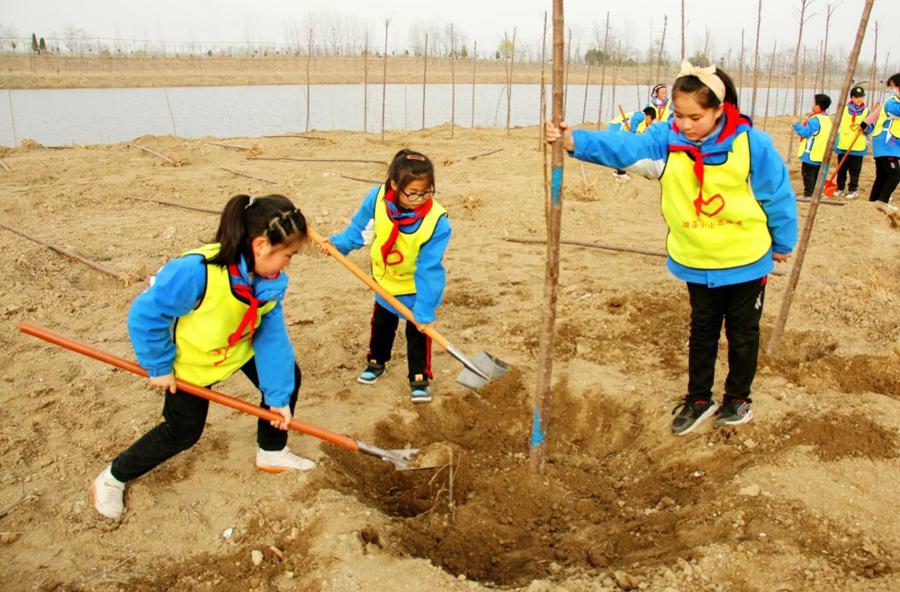China's forests are taking up more CO2 than previous studies had calculated
The Earth is warming at an unprecedented rate. This is due primarily to rising atmospheric levels of carbon dioxide (CO2), which has the ability to absorb and radiate heat. As the Earth has warmed, we have begun to see major changes in all aspects of our interconnected physical and biological world. As the warming continues, some of these changes will become irreversible and will inevitably result in shifts in the way we live our everyday lives.

On March 22, in the Yudaoyuan Ecological Scenic Area of Tangjia Village, Duiqiao Town, Jinxi County, Fuzhou City, Jiangxi Province, various seedlings were distributed in patches and were full of vitality. (People’s Daily Online/Deng Xingdong)
The Paris Agreement describes a global strategy that aims to keep global mean temperatures to within 2oC Celsius of those from the pre-industrial era in the late 19th century, with an aspirational aim of remaining within 1.5oC. To achieve this aim, carbon (principally CO2 and methane) emissions have to at least halve every decade over the next century. Are these goals achievable? The answer to my question relies on the global community pledging and, more importantly, enacting large, progressive reductions in carbon emissions.
The headline we reported in Nature in October was that China's forests are taking up more CO2 than previous studies had calculated. We found that Chinese vegetation absorbed a mean value of 1.11 petagrams of carbon every year of our study period (2010 to 2016). A petagram is a million, billion grams. To put that into context, that is 45% of China's CO2 emissions. Our work revealed that previous studies underestimated the amount of CO2 that is absorbed via photosynthesis throughout the year in Yunnan, Guizhou and Guangxi provinces. We also found large CO2 uptake in Heilongjiang and Jilin provinces during summer months, replaced by a diffuse source from respiration during winter months.

On March 10, more than 20 students from the No. 1 Experimental School of Suixi County, Huaibei City, Anhui Province participated in voluntary tree planting activities at the green spot of Hongnan Village, Sipu Town. (People’s Daily Online/Zhou Fangling)
To convince our scientific colleagues, and ourselves, of the larger than expected magnitude of this carbon uptake we found from provincial-scale forest census it required afforestation rates that ranged 0.04 million to 0.44 million hectares per year for the past 10 to 15 years. That area is equivalent to adding between 56,000 to 616,000 football pitches of forest to individual provinces every year. Using satellite observations, we also found a significant upward rise in vegetation greenness and above-ground biomass. This additional evidence is consistent with a large carbon uptake.
The Nature study clearly shows the value of massive-scale and long-term afforestation, so I hope that China will sustain and build on these activities. Expanding the network of ground-based measurements to improve understanding how carbon is being absorbed and stored in these forests and soils will help to develop national strategies to minimize that carbon being subsequently released into the atmosphere.
Our study also highlighted how independent satellite observations of CO2 were consistent with estimates of CO2 uptake inferred from the ground-based data. This bodes well for the future role of satellite observations in quantifying national carbon budgets as part of the Paris Agreement global stocktakes. The first Chinese CO2-measuring satellite, TanSat, was launched at the end of 2016 and is a successful start of a new national capability to monitor CO2 from space.

On February 24, the vehicle drove on a rural road between green trees in Gangbian Township, Congjiang County, Guizhou Province. (People’s Daily Online/Luo Jinglai)
TanSat reinforces a long-term and fruitful collaboration between Chinese and European researchers on CO2 monitoring, supported by the Ministry of Science and Technology of the People's Republic of China (MOST) and European Space Agency (ESA). TanSat has recently become an ESA third party mission, encouraging wider collaborative science activities that use its CO2 data.
What does the future hold? I was genuinely excited to hear about China's net zero plans: CO2 emissions peaking before 2030 and carbon neutrality before 2060. Making this happen will take a herculean effort but one worth the effort. Achieving China's appropriately ambitious net zero target will require massive structural changes to power generation to accompany the existing afforestation programme and other forms of negative emission technologies. We cannot rely on one single approach – they must all be developed in concert.
Technology is not a panacea. Meeting the demands of the Paris Agreement also requires changes in the way we live and do business. These will be generation-defining changes.
Palmer Paul is the professor of University of Edinburgh.
Photos
Related Stories
- Walk the talk: Xi leads China in fight for carbon-neutral future
- Interview: There's "huge scope" for U.S.-China cooperation on climate change -- expert
- European Commission adopts new strategy on climate change adaptation
- China ready to strengthen climate change cooperation with international community: spokesperson
- World risks "collapse of everything" without strong climate action, warns British naturalist
- 2021 "crucial year" for climate change, UN chief tells member states
- China calls for global cooperation to address climate change
- Benign interactions among major countries indispensable for tackling climate change
- U.S. should show its seriousness about climate change: spokesperson
- China's green commitment boosts global fight against climate change: UNDP official
Copyright © 2021 People's Daily Online. All Rights Reserved.










